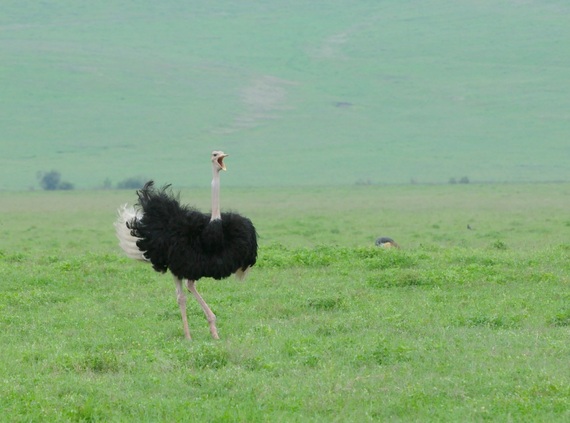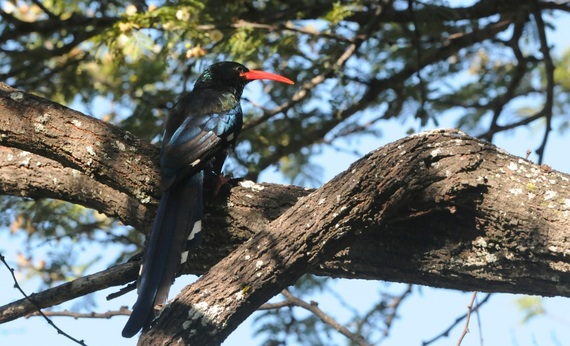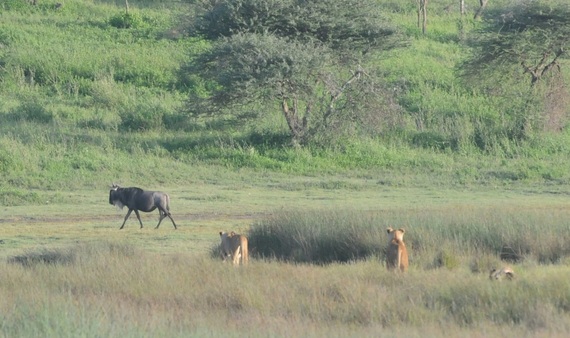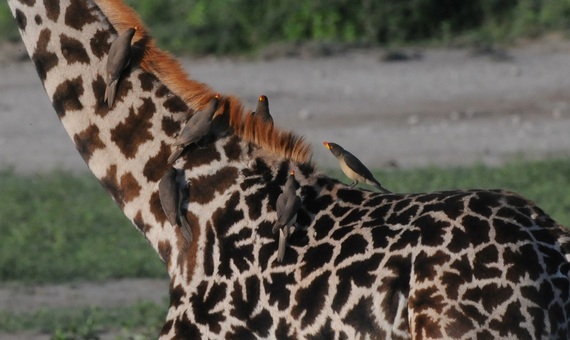"We should wait here," our expert driver and guide David Mboya intoned. These lions will rouse and might pursue one of the wildebeest. David, a Maasai who left the pastoralist life at an early age to seek an education, has led tours in the Serengeti for 14 years and has a particularly keen eye for animal behavior. So we waited.
My wife and I had come to Tanzania to celebrate our 20th anniversary. For my wife, this was a first visit to Africa. For me, it was both a chance to see the wildlife through her excited eyes and an opportunity to experience the wildebeest and zebra migration 30 years after being on the Kenya side of it in the Mara, at the Serengeti's most northern boundary.
Ostrich are unique to Africa and characteristic of the immense savannas. Photo by Steve Zack/WCS.
We toured Serengeti National Park and nearby Ngorongoro Crater, Tarangire, and Lake Manyara. At some 12,000 square miles, the Serengeti Ecosystem with its nearby wildlife reserves are together big enough to contain the Great Migration of the wildebeest, zebra, and Thomson's gazelle along with all the elephants, giraffe, lions, cheetah, etc. and -- of course! -- many fabulous birds of East Africa (many, unique to Africa, are shown here).
Weeks later, I still feel the overwhelming spectacle of the migration and the vast grasslands and woodlands of the Serengeti, which for the Maasai people means "endless plains." This landscape, our planet's most historic place of wildlife abundance, has a profound resonance owing to its deeper connection to our own savanna origins -- evidenced by the nearby fossils and preserved footprints of Olduvai Gorge.
That the Serengeti exists and endures is the result of quirky history, dedicated conservationists, and intense worldwide tourism. Tsetse flies are its original conservationists. Without their irritating bites (I still have a few) and worrisome diseases, Serengeti woodlands would have been permanently settled by either African pastoralists or expanding European colonists.
Green Woodhoopoes are relatives of kingfishers, and live in groups where non-breeding helpers bring food to nestlings in cavities. Photo by Steve Zack/WCS.
The culture of the Maasai is also fundamental to the Serengeti. They tend livestock for sustenance and so for centuries have coexisted with the big mammals of East Africa without greatly exploiting them. (The politics of the Maasai and the Serengeti are complex and include contentious evictions out of what is now the park.)
But the Serengeti persists today because of the more than one million tourists who come to Tanzania each year, providing fully one-quarter of its foreign exchange. For most, this will be the centerpiece of their visit. Safari vehicles bring you close to the wildlife and the lodges are very posh. Our trip of a lifetime cost a good fraction of our travel savings. A big expense for a priceless landscape.
It is a relevant and essential investment in our quality of life on earth. My wife's and my experience last month, like your own past or future visits to other parks or protected areas, helps to remind us of the biological heritage we share.
Lions approach a lone wildebeest in the southern Serengeti. Photo by Steve Zack/WCS
Protected areas like parks and reserves are the backbone of wildlife conservation. The U.S. National Park Service turns 100 in 2016 and celebrate it we should. The park service largely created the idea of parks for wildlife conservation worldwide. Yellowstone, Grand Teton, and Denali are all part of that legacy.
The Wildlife Conservation Society (WCS), for which I work, has a long and storied role in the creation and management of parks and protected areas worldwide. Half a century ago, as the New York Zoological Society, we helped create both Grand Teton National Park and the Arctic National Wildlife Refuge in the U.S. In recent years, the diversity of approaches and the breadth of our partnerships have redefined how protected areas are established and managed.
Red-and-Yellow Barbets are part of a colorful, and highly vocal, group of birds unique to Africa. Photo by Steve Zack/WCS.
For instance, recently we helped to establish Ntokou-Pikounda National Park in the Republic of Congo to protect the 15,000-plus lowland gorillas WCS discovered there. In South America, we have been active for two decades working in Madidi National Park, helping local people establish legal tenure over their lands and bringing under management an area of 19,000 square kilometers that holds 11 percent of the world's bird species.
In Cambodia, WCS works with wildlife ministry officials, local communities, and tourism operators at Tonle Sap Lake to recover -- and now maintain -- the largest waterbird nesting colonies in Asia, while in Afghanistan WCS has just helped establish the 4,200-square-mile Wakhan National Park.
Yellow-billed Oxpeckers, starling relatives, forage on the hides of large mammals, eating insects, tics, and sometimes the blood from insect bites. Photo by Steve Zack/WCS.
The Serengeti is one of the biggest and most magical of our last great places for wildlife left on the planet. Not all protected areas receive thousands, let alone millions of visitors and their money. Yet in our increasingly crowded world, we need to continue to protect and value those few places where wildlife is secure.
Back with David Mboya, our Massai guide, we waited. The lone wildebeest darted away from the marsh without ever seeing the lions approaching. The lions shrugged and went back to sleep. There would be many, many more wildebeest nearby. They were content in a land of plenty. We drove on to our next great viewing, also contented.




